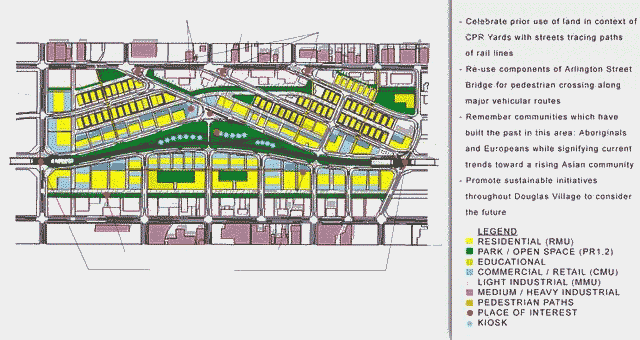
2012
|


30 July 2012
Plan Sees CP Yards as Rail Estate
Winnipeg Manitoba - The tracks that divide Winnipeg could become a ribbon of parkland and trails that form the backbone of an
innovative new neighbourhood for 8,000 people.
Douglas Village is a conceptual design created last year by University of Manitoba graduate Don Reimer as part of his professional architecture degree
coursework through the Royal Architectural Institute of Canada. Reimer's work is the first detailed plan for what the 86-hectare marshalling yards could be if
the land was available for redevelopment.
"I think Winnipeg is viewed as a city without a vision," said Reimer, who works full-time for Nejmark Architect in Winnipeg. "We do things
because we like things that are economically sound right now without necessarily thinking of the future. But there are times when we surprise everyone, with
The Forks, for example."
Reimer envisions a compact, dense, neighbourhood where services such as doctors' offices, shops, and schools are within walking distance and where middle and
upper-class homes are nestled in with affordable units of all types, co-ops, row houses, apartment buildings, seniors units, and more traditional single-family
houses.
Reimer used the tracks as the spine of the design, creating a central pedestrian path and through roads that mirror the curve of the existing tracks. Parts of
the iconic Arlington Bridge, now 100-years-old, could be reused in new pedestrian crossings and plentiful public art would remind visitors of the land's
130-year history as a major railway transportation hub.
Light industrial businesses would be located around the periphery of the yards, buffered by a strip of green space, and commercial and residential development
would be located in the core of the neighbourhood.
The design even includes land for community gardens, a railway museum, a restaurant district, a hotel, and day cares co-located with schools.
The CP main line presents one of the biggest challenges to redevelopment. Relocating it likely means moving several spur lines, and involves far more money and
hassle than the already-mammoth task of moving the railway yards. Leaving the main line in place, though, means the city would still need to spend money on a
series of underpasses and bridges.
Reimer suggests putting the main line underground, an admittedly large undertaking.
Since trains are the historic life of the city, another option, said Richard Milgrom, city planning professor at the University of Manitoba, could be leaving
it in place and building around it, like Toronto when it developed the mixed-income neighbourhood near the St. Lawrence Market next to the VIA Rail line.
Key to redeveloping the yards, especially in a slow-growth city where suburban development has historically eclipsed new projects in the core, is ensuring a
new neighbourhood contributes to what's already on either side. That includes historic Selkirk Avenue, which is already struggling to keep businesses and could
be further cannibalized by another nearby commercial district.
"Planners need to consider not just what's on the rail yard but what's beyond that, how these things blend together," Milgrom said. "How are we
improving existing neighbourhoods by building on this land?"
Mary Agnes Welch.

|


|
Vancouver Island
British Columbia
Canada
|
|